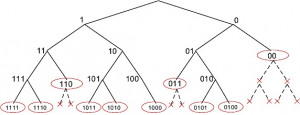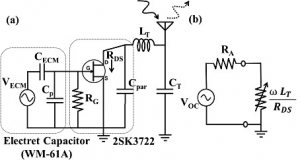 Congratulations to all of these authors for being nominated for the best paper award! The winner will receive a $500 award! The winner will be announced during the Opening Plenary Session on Wednesday, May 1 at 8:30am. Thank you to ThingMagic for sponsoring the best paper award winner!
Congratulations to all of these authors for being nominated for the best paper award! The winner will receive a $500 award! The winner will be announced during the Opening Plenary Session on Wednesday, May 1 at 8:30am. Thank you to ThingMagic for sponsoring the best paper award winner!
Sensor Enabled Wearable RFID Technology for Mitigating the Risk of Falls Near Beds
Roberto Luis Shinmoto Torres, Qinfen Shi, Alanson Sample, Damith C. Ranasinghe (University of Adelaide, AU; Intel Labs, US)

The increasing aging population around the world, associated with their increased risk of falling, challenges society and technology to find better ways to mitigate the occurrence of such costly and detrimental events as falls in elderly population. The most common activity associated with falls is bed transfers; thus, the most important high risk activity. Several technological solutions exist for bed exiting detection using a variety of sensors which are attached to the body, bed or floor. However, lack of real life performance studies, technical limitations and acceptability are still key issues. In this research, we present and evaluate a novel method for mitigating falls high risk for bed exits which is inexpensive, privacy preserving and light process. Our approach is based on an classification system based on conditional random fields that requires almost no preprocessing of sensorial and RF metrics data extracted from an RFID platform. We tested our approach on elderly patients (66-86 y.o.). The results of our trials are compared with performance metrics from previous bed exit classification studies. We also present the acceptability of RFID technology in an elderly population.
Minimum Energy Source Coding for Asymmetric Modulation with Application to RFID
Farzad Hessar, Sumit Roy (University of Washington, US)

Minimum energy (ME) source coding is an effective technique for efficient communication with energy-constrained devices, such as sensor network nodes. In this paper, the principles of generalized ME source coding is developed that is broadly applicable. Two scenarios – fixed and variable length codewords – are analyzed. The application of this technique to RFID systems where ME source coding is particularly advantageous due to the asymmetric nature of data communications is demonstrated, a first to the best of our knowledge.
Hybrid Analog-Digital Backscatter: A New Approach for Battery-Free Sensing
Vamsi Talla, Joshua R. Smith (University of Washington, US)
 After comparing the properties of analog backscatter and digital backscatter, we propose that a combination of the two can provide a solution for high data rate battery free wireless sensing that is superior to either approach on its own. We present a hybrid analog-digital backscatter platform that uses digital backscatter for addressability and control but switches into analog backscatter mode for high data rate transmission of sensor data. Using hybrid backscatter, we report the first digitally addressable real-time battery free wireless microphone. We develop the hybrid backscatter platform by integrating an electret microphone and RF switch with a digital RFID platform (WISP). The hybrid WISP operates by default in digital mode, transmitting and receiving digital data using the EPC Gen 2 RFID protocol but switching into analog mode to backscatter audio sensor data when activated by Gen 2 READ command. The data is recovered using a USRP-based Software Defined RFID reader. We report an operating range of more than 2.7 meters for the microphone-equipped hybrid WISP which can be extended to 4.7 meters using a higher output power reader.
After comparing the properties of analog backscatter and digital backscatter, we propose that a combination of the two can provide a solution for high data rate battery free wireless sensing that is superior to either approach on its own. We present a hybrid analog-digital backscatter platform that uses digital backscatter for addressability and control but switches into analog backscatter mode for high data rate transmission of sensor data. Using hybrid backscatter, we report the first digitally addressable real-time battery free wireless microphone. We develop the hybrid backscatter platform by integrating an electret microphone and RF switch with a digital RFID platform (WISP). The hybrid WISP operates by default in digital mode, transmitting and receiving digital data using the EPC Gen 2 RFID protocol but switching into analog mode to backscatter audio sensor data when activated by Gen 2 READ command. The data is recovered using a USRP-based Software Defined RFID reader. We report an operating range of more than 2.7 meters for the microphone-equipped hybrid WISP which can be extended to 4.7 meters using a higher output power reader.
Analysis of Wireless Powering of mm-Size Neural Recording Tags in RFID-inspired Wireless Brain-Machine Interface Systems
Elham Moradi, Toni Björninen, Lauri Tapio Sydänheimo, Leena Ukkonen, Jan Rabaey (Tampere University of Technology, FL; UC Berkeley, US)
 This paper provides a full analysis of powering mm-size cortical implants wirelessly. An effective approach for wireless power and data transfer in neurorecording microsystems is the backscattering-based RFID-inspired communication. In this mechanism, an external interrogator powers the implant unit by microwave radiation power, and the implant IC superimposes the neurosignal on top of the signal backscattered to the interrogator. This paper characterizes wireless RF link between an external transmit antenna and an implantable antenna using the two-port model. It presents the design of a novel 1-mm3 implantable loop antenna and four different external loop antennas with various features to analyze aspects and factors limiting the wireless power transfer.
This paper provides a full analysis of powering mm-size cortical implants wirelessly. An effective approach for wireless power and data transfer in neurorecording microsystems is the backscattering-based RFID-inspired communication. In this mechanism, an external interrogator powers the implant unit by microwave radiation power, and the implant IC superimposes the neurosignal on top of the signal backscattered to the interrogator. This paper characterizes wireless RF link between an external transmit antenna and an implantable antenna using the two-port model. It presents the design of a novel 1-mm3 implantable loop antenna and four different external loop antennas with various features to analyze aspects and factors limiting the wireless power transfer.
Wide-Coverage Array Antenna Using a Dual-Beam Switching for UHF RFID Applications
Wang-Sang Lee, Seung-Tae Khang, Won-Seok Lee, Hyunsung Tae, Moon-Que Lee, Jong-Won Yu (Korea Advanced Institute of Science and Technology, KR; University of Seoul, KR)
 Based on a dual-beam switching, the wide-coverage array antenna with a 4X4 proposed matrix which generates three dual-beams is presented for the ultra high frequency (UHF) radio frequency identification (RFID) applications. The 4X4 proposed matrix generates the three dual-beams which can cover the wide spatial coverage of 180 degree. The main beam directions can be controlled by selecting the appropriate input port of the proposed matrix. Due to the compact structure and very low reflection coefficient, the circular polarized square quadrifilar spiral antenna (QSA) array incorporated with the 4X4 proposed matrix has been configured. The fabricated array antenna operates at the 902-928 MHz band and produces three dual-beams at ±12, ±39, and ±68 degrees.
Based on a dual-beam switching, the wide-coverage array antenna with a 4X4 proposed matrix which generates three dual-beams is presented for the ultra high frequency (UHF) radio frequency identification (RFID) applications. The 4X4 proposed matrix generates the three dual-beams which can cover the wide spatial coverage of 180 degree. The main beam directions can be controlled by selecting the appropriate input port of the proposed matrix. Due to the compact structure and very low reflection coefficient, the circular polarized square quadrifilar spiral antenna (QSA) array incorporated with the 4X4 proposed matrix has been configured. The fabricated array antenna operates at the 902-928 MHz band and produces three dual-beams at ±12, ±39, and ±68 degrees.
